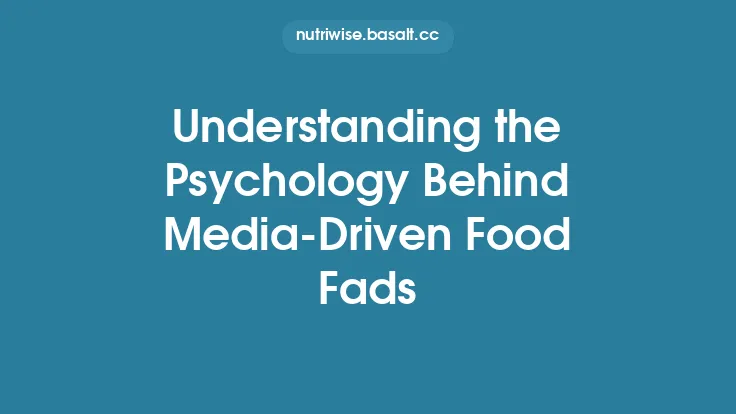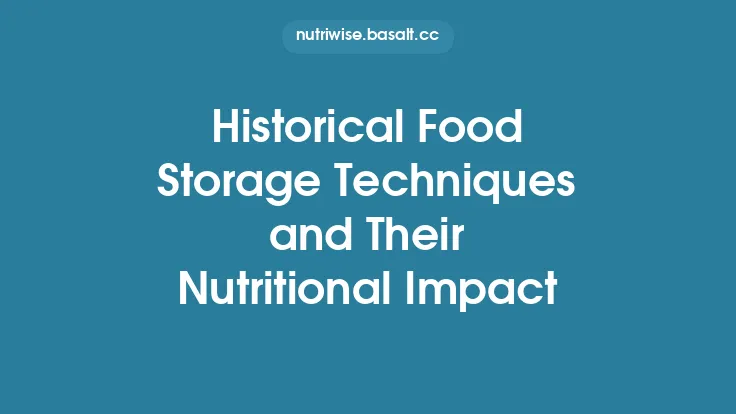Food superstitions—those seemingly irrational rules that dictate what we should or shouldn’t eat on particular days, during specific events, or under certain conditions—are woven into the fabric of many cultures. While they often appear as quaint folklore, they are underpinned by robust psychological processes and can exert measurable effects on dietary patterns and nutritional status. This article delves into the mental mechanisms that give rise to food‑related superstitions, illustrates how they manifest across societies, and evaluates the ways in which they shape nutrient intake, health outcomes, and public‑health interventions.
Historical Roots of Food Superstitions
1. Survival‚ÄëBased Origins
Early human groups relied on trial‑and‑error learning to avoid poisonous or spoilage‑prone foods. When a particular plant or animal caused illness, the memory of that adverse event was encoded as a cautionary rule—often expressed in mythic or ritual language. Over generations, the original empirical observation became abstracted into a superstition (e.g., “Never eat fish on a full moon” in certain coastal societies, originally linked to higher rates of spoilage due to nocturnal temperature fluctuations).
2. Religious and Cosmological Frameworks
Many ancient belief systems linked the macro‑cosmos (celestial bodies, seasonal cycles) with the micro‑cosmos of the human body. The principle of *sympathetic magic*—the idea that “like affects like”—produced prescriptions such as avoiding “cold” foods during winter to maintain internal warmth. Although the cosmological rationale is no longer scientifically endorsed, the behavioral injunction persists as a cultural superstition.
3. Social Cohesion and Identity Markers
Superstitious food practices often serve as markers of group identity. Refusing to eat a particular dish during a communal ceremony can signal allegiance to the group’s shared narrative. The psychological need for belonging reinforces adherence, even when the original rationale has been forgotten.
Cognitive Mechanisms Driving Superstitious Beliefs
1. Operant Conditioning and Reinforcement
When a specific food choice coincides with a positive outcome (e.g., a successful harvest after abstaining from a certain grain), the behavior is positively reinforced. Conversely, negative outcomes (illness, bad luck) after consuming a particular food produce punishment, strengthening avoidance. Over time, the association becomes a rule that is applied even when the causal link is spurious.
2. Illusory Correlation
Humans are predisposed to detect patterns, even where none exist. If a family experiences a misfortune after a wedding banquet featuring a certain fruit, the coincidence may be interpreted as causal, leading to a superstition that the fruit brings bad luck. This bias is amplified by selective memory—instances that confirm the belief are remembered, while contradictory cases fade.
3. Perceived Control and Anxiety Reduction
Superstitions provide a sense of agency in uncertain situations. During high‚Äëstress events (e.g., exams, medical procedures), adhering to a food ritual (such as eating a specific snack before a test) can reduce anxiety, even if the ritual has no physiological effect. The psychological comfort can indirectly influence performance and health behaviors.
4. Social Learning Theory
Observational learning allows individuals to acquire superstitious practices by watching elders or peers. The model’s status (e.g., a respected elder) enhances the perceived credibility of the superstition, facilitating intergenerational transmission.
Common Global Food Superstitions and Their Nutritional Consequences
| Region / Culture | Superstition | Typical Food Involved | Nutritional Impact |
|---|---|---|---|
| East Asia | Avoid eating “round” foods (e.g., dumplings) during a lunar eclipse, believing they will “reflect” bad luck. | Dumplings, rice balls | Reduced intake of carbohydrate‑rich foods on specific days may lead to short‑term energy deficits, especially in populations with limited dietary diversity. |
| Southern Europe | Never serve fish on Fridays during Lent unless it is “white” (symbolizing purity). | Dark‑fleshed fish (e.g., sardines) | Potential deficiency in omega‑3 fatty acids if the restriction persists beyond the religious period, affecting cardiovascular health. |
| Latin America | Eating grapes at midnight on New Year’s Eve brings twelve months of good luck. | Red grapes | Overconsumption of grapes can lead to excess fructose intake, potentially aggravating insulin resistance in susceptible individuals. |
| Sub‑Saharan Africa | Avoid “bitter” leafy greens during the planting season, believing they will “spoil” the crops. | Amaranth leaves, kale | Excluding bitter greens reduces intake of micronutrients (vitamin K, calcium, iron) and phytochemicals (glucosinolates) that have protective health effects. |
| South Asia | Do not consume lentils on Tuesdays, as they are thought to attract “evil spirits.” | Dal (lentils) | Lentils are a primary protein source for many vegetarians; avoidance can lead to temporary protein shortfalls, especially in low‑income households. |
| Middle East | Eating pomegranate seeds during a wedding is believed to ensure fertility. | Pomegranate | While generally beneficial (rich in antioxidants), excessive consumption may cause gastrointestinal discomfort due to high fiber content. |
These examples illustrate that superstitions can both limit the intake of nutrient‚Äëdense foods (risking deficiencies) and encourage overconsumption of less‚Äënutritive items (risking excess calories, sugars, or fats).
The Role of Social Transmission and Ritual
1. Formal vs. Informal Channels
Superstitions are propagated through formal mechanisms (religious texts, cultural festivals) and informal ones (family anecdotes, social media memes). The latter has accelerated the spread of modern food superstitions—e.g., viral claims that “eating honey before a job interview guarantees success”—which can alter short‑term dietary choices.
2. Ritualistic Reinforcement
Rituals embed superstitions within a structured sequence of actions, enhancing memory encoding. The repeated pairing of a specific food with a ceremonial context (e.g., “black-eyed peas on New Year’s Day for prosperity”) strengthens the belief through procedural memory, making it resistant to rational counter‑arguments.
3. Group Norms and Conformity Pressure
When a community collectively observes a food taboo, deviation can result in social sanction. The fear of ostracism can outweigh personal health considerations, compelling individuals to maintain the superstition even when it conflicts with medical advice.
Psychological Benefits and Placebo Effects
1. Stress Buffering
Adhering to a familiar food ritual can lower cortisol levels by providing predictability. Studies have shown that participants who ate a “lucky” snack before a stressful task reported lower perceived stress and performed comparably to those who received a calming intervention.
2. Placebo‚ÄëMediated Health Perceptions
Belief in the protective power of a food (e.g., “garlic wards off illness”) can trigger a placebo response, leading to subjective improvements in well‑being. Neuroimaging research indicates activation of reward pathways (ventral striatum) when participants consume foods they deem “protective,” which may translate into measurable physiological changes such as modest reductions in blood pressure.
3. Enhanced Dietary Mindfulness
Superstitious rules often require conscious attention to food selection, inadvertently promoting mindful eating. This heightened awareness can improve portion control and encourage reflection on hunger cues, offering indirect nutritional benefits.
Nutritional Risks and Mitigation Strategies
1. Identifying High‚ÄëRisk Superstitions
- Exclusion of staple proteins (e.g., lentils, beans) can precipitate protein‚Äëenergy malnutrition.
- Overreliance on sugary “lucky” foods (e.g., grapes, honey) may exacerbate glycemic control issues.
- Avoidance of micronutrient‚Äërich vegetables (e.g., bitter greens) can lead to deficiencies in iron, calcium, and vitamin A.
2. Public‚ÄëHealth Communication Approaches
- Culturally Tailored Messaging: Frame nutritional advice within the existing belief system (e.g., “Enjoy your lucky grapes, but balance them with a handful of nuts for sustained energy”).
- Community Champions: Engage respected elders or religious leaders to endorse modified practices that preserve cultural identity while improving nutrient adequacy.
- Behavioral Nudges: Introduce subtle cues (e.g., placing fortified foods alongside traditional “lucky” items) to encourage healthier choices without confronting the superstition directly.
3. Clinical Interventions
- Nutritional Counseling: Assess patients’ food superstitions during dietary history taking to identify potential gaps.
- Supplementation: When avoidance of specific foods is entrenched, targeted supplementation (e.g., iron tablets for those who avoid leafy greens) can prevent deficiencies.
- Cognitive‚ÄëBehavioral Techniques: Help individuals reframe superstitious beliefs by challenging illusory correlations and reinforcing evidence‚Äëbased dietary practices.
Research Methodologies and Future Directions
1. Mixed‚ÄëMethods Designs
Combining ethnographic fieldwork (participant observation of rituals) with quantitative dietary assessments (24‚Äëhour recalls, food frequency questionnaires) yields a comprehensive picture of how superstitions translate into nutrient intake.
2. Experimental Paradigms
Laboratory studies that manipulate belief (e.g., informing participants that a neutral food is “lucky”) can isolate the causal impact of superstition on eating behavior, appetite, and metabolic markers.
3. Longitudinal Cohort Analyses
Tracking populations over time allows researchers to examine whether adherence to specific food superstitions predicts health outcomes such as BMI trajectories, incidence of anemia, or cardiovascular events.
4. Neurocognitive Investigations
Functional MRI and EEG studies can elucidate the brain circuits activated when individuals make food choices under superstitious influence, shedding light on the interplay between reward, fear, and decision‚Äëmaking networks.
Practical Guidance for Navigating Food Superstitions
- Self‚ÄëAudit: List the food superstitions you observe and note the associated foods, frequency, and context.
- Nutrient Mapping: Identify the key nutrients supplied by those foods and assess whether your overall diet compensates for any exclusions.
- Balanced Substitutions: Replace restricted items with nutritionally equivalent alternatives that are culturally acceptable (e.g., swap avoided dark‚Äëfish with fortified plant oils for omega‚Äë3s).
- Portion Control: If a superstition encourages overconsumption of a high‚Äësugar food, limit the portion and pair it with protein or fiber to blunt glycemic spikes.
- Seek Professional Input: Discuss any persistent dietary restrictions with a dietitian who can help integrate cultural practices with evidence‚Äëbased nutrition.
- Mindful Flexibility: Recognize that many superstitions are symbolic rather than prescriptive; allowing occasional flexibility can preserve cultural meaning while supporting health.
Food superstitions are more than whimsical anecdotes; they are the product of deep‑seated psychological processes that shape what we eat, when we eat it, and how we feel about those choices. By unpacking the cognitive underpinnings and nutritional ramifications, we can respect cultural heritage while fostering dietary patterns that promote long‑term health. The challenge lies in striking a balance—honoring the symbolic power of food rituals without compromising the body’s nutritional needs.





